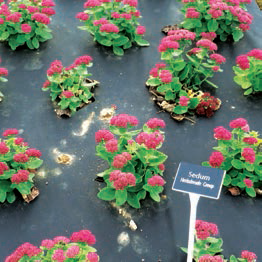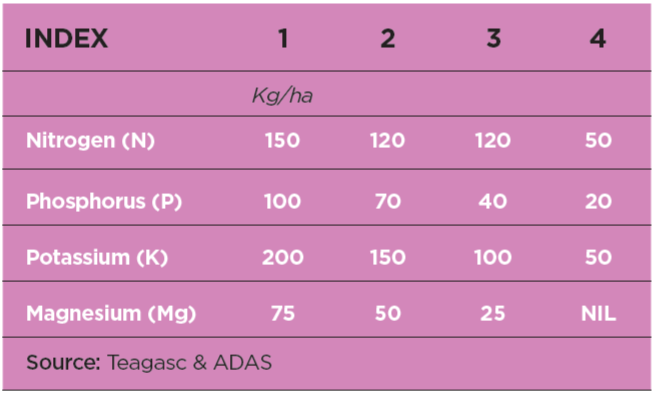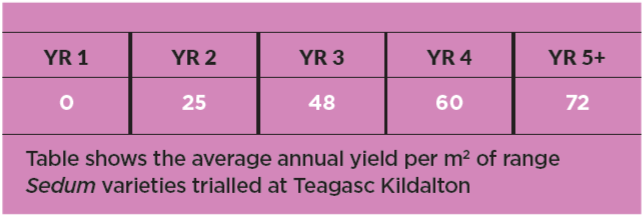Andy Whelton shares the results of trial work exploring the use of Sedum as autumn cut flower filler
Sedum is a hardy, herbaceous perennial plant with thick, succulent leaves, fleshy stems and clusters of star-shaped flowers. It has been used in mixed borders for many years but more recently, a low growing, hardy species has become a vital element of green roof mats, thanks to its ability to stand up to weather extremes.
The border species are the taller Sedum; a traditional favourite in many gardens guaranteeing vibrant autumn colour. But it is also gaining popularity in the cut flower trade as an autumnal flower filler or straight-line, thanks to the introduction of new cultivars specially bred for the bouquet trade.
Teagasc Horticultural Development Unit trialled some of these new introductions at Kildalton College over the past few years, resulting in a blueprint for commercial production of the species, which I have outlined below.
SHELTER, SITE AND SOIL

As with all cut flowers and foliage, a sheltered site is necessary and while a south-facing site is desirable it is not essential. Light to medium, well-drained soils are best but they grow on a wide range. The pH should be between 6-7. Plants are normally planted in spring from rooted cuttings or modules and should not be planted too deep – the eyes should be seen just at ground level. The crop is generally planted at high density on the flat or on raised beds. Plant in 1m to 1.2m wide beds at six plants/m2 (40 cm x 40 cm). High density ensures that stems will grow straight once established after two years. Plantations should be renewed by dividing plants every five to six years as stem length and quality can be impacted.
NUTRITION
A soil test is necessary to accurately determine rates of phosphorus and potassium. The following amounts should be applied according to soil analysis:
A top-dressing of up to 80 – 100 kg/ha of nitrogen is applied in the spring of second and subsequent years.
RANGE OF VARIETIES

Sedum flowers appear in the autumn and tend to be in shades of pink and mauve that start out pale and deepen as they mature, but they can also be white, yellow, red and, rarely, blue. Of the cultivars trialled at Teagasc Kildalton, a traditional well-known variety, Sedum ‘Herbstfreude’ (syn. S. ‘Autumn Joy’), gave high yields of long thick stems (60 cm) with large pink flower heads up to 20 cm in diameter. Sedum Spectabile ‘Brilliant’ is an older variety that produces large sprays of flat heads of pinkish-mauve flowers but shorter stems at 45 cm. Some of the Dutch-bred ‘Kolster’ varieties such as Sedum ‘Magical Lizzy’ and ‘Magical Twist’ whilst lower yielding than some of the traditional varieties are particularly suitable for the supermarket bouquet trade, having smaller flower heads and satisfactory stem length of 52-60 cm. Sedum ‘Matrona’ with pigeon-grey to smoke-purple foliage and soft pink flowers and Sedum telephium ‘Purple Emperor’ with almost black foliage and red-purple flower heads both produced stems with length ideally suited to the straight line bouquet market.
WEEDS
It is important to keep plantations free of weeds. Given that herbaceous perennials will be in the ground for a number of years, it is critical that the site has first been cleared of perennial weeds by spraying off, using a mixture of Glyphosate (Roundup) and Carfentrozone-Ethyl (Spotlight Plus).

The choice of herbicides to maintain clean plantations depends on the weed spectrum and while there are some off label approvals, residual herbicide control can be challenging with this crop. A crop on bare soil can quickly become infested if not managed for weeds. The trial at Kildalton was planted at high density on beds using a weed barrier – Daltax as in the picture. This is a similar product to Mypex mulch but has the added advantage of allowing chemical fertilisers through. However, it is necessary to trim the fabric around the plants annually to allow new shoots to develop and the plants to expand.
CROP SUPPORT
Some of the Sedum cultivars are long-stemmed and can be top-heavy when flowering especially after rain. This can cause bending of the stems but this can be minimised by supporting the sides of the beds or rows with a wired system of support. The crop should be pruned back to within 20 cm of the ground level once harvesting is complete. Crop debris should be removed and destroyed.
PESTS AND DISEASES
Aphids and slugs are key pest threats. It is also essential to fence a site from rabbits or hares. The crop is susceptible to Botrytis (Grey mould) and powdery mildew. The crop will have to be monitored and treated accordingly. The biological fungicide Bacillis subtillis (Serenade ASO) is a useful protectant.
HARVEST AND YIELD
While it is possible to harvest in the first year, the stems tend to be short so it is recommended to pinch the plant in the first year just as they begin to sprout out and begin the main harvest in the second year. Sedum can be harvested green, at the flower bud stage or at full flower. This gives the crop a long harvest period of up to eight weeks. Generally, stems are cut early in the morning and moved to the cold store to maintain quality. Sedum are generally sorted into lengths 40-50 cm. Stems are bunched in 5’s and chilled at 1-3C. New plants produce three to five stems in the second year. Whilst varieties can vary in terms of yield, an average of 12-15 stems can be produced from a well-managed crop at full maturity.
CONCLUSION
Given the increase in Irish capita expenditure on cut flowers and with positive economic growth and an expanding population, it looks like there is an increasing demand and a growing appetite for a greater variety in the flowers and foliages available, like Sedum.
Teagasc is hosting an event at Kildalton College on Thursday, July 23, from 11am – 2pm for anyone interested in seeing the Sedum trials and hear about opportunities in cut foliage/flower production. ✽
 Andy Whelton, a specialist in ornamental cut foliage crops in the Teagasc Horticultural Development Unit, continues his series of articles on the agronomy and screening work on innovative novel plant material being trialled in Kildalton College for use in the floristry trade. Andy Whelton, a specialist in ornamental cut foliage crops in the Teagasc Horticultural Development Unit, continues his series of articles on the agronomy and screening work on innovative novel plant material being trialled in Kildalton College for use in the floristry trade.
Contact andy.whelton@teagasc.ie |





